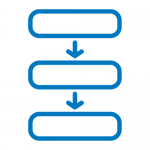About the Program
ONLINE | FULL-TIME, PART-TIME
SCHOLARSHIPS AVAILABLE
ONLINE | FULL-TIME, PART-TIME
SCHOLARSHIPS AVAILABLE
The MS in Population Health Informatics addresses the growing opportunity to use technology to implement evidence-based solutions for the improvement of population health outcomes. While most health informatics programs take a hospital-centric approach, this innovative first-of-its-kind program focuses on how to operationalize informatics solutions to address important public health challenges impacting individuals, families, communities, and the environment in which they live.
While we cannot issue I-20 forms for a fully online degree program, our online offerings provide a chance for international students to earn an affordable, quality degree from the City University of New York while residing in their home country.
This program is designed for working professionals looking to expand their existing knowledge and skills, extend their networks and explore how technology at the intersection of clinical care and health sciences can be used to strengthen efforts for preventative care at the population level towards a more equitable public health.
This program offers practical coverage of critical topics such as big data, cloud computing, mobile health, surveillance and visualization all from the perspective of the end user. Students are provided with the skills and expertise to design, develop, implement and evaluate technology-enabled interventions and solutions to address tomorrow’s pressing population health challenges today.
From clinical analysts who coordinate patient care across systems to informatics directors who use AI and big data to improve community health outcomes, this innovative degree will give students the foundation they need to utilize technology to address the toughest public health issues across sectors.


This degree program is fully online.
| Foundational Knowledge (0 credits) | PUBH 601 Foundations of Public Health Knowledge* |
| Core Coursework (15 credits) | PUBH 610 Public Health Leadership and Management |
| PUBH 611 Health Equity, Communication, and Advocacy | |
| PUBH 612 – Designing and Evaluating Public Health Interventions | |
| PUBH 613 Designs, Concepts, and Methods in Public Health Research | |
| PUBH 614 Quantitative and Qualitative Data Analysis Methods in Public Health Research | |
| Required Coursework (18 credits) | EPID 630 Fundamentals of Population Health Informatics |
| EPID 631 Principles of Consumer Health Informatics | |
| EPID 632 Applications of Population Health Informatics | |
| EPID 633 Design and Development of Population Health Information Systems | |
| EPID 634 Population Health Dashboards | |
| EPID 635 Mobile Health Interventions: Opportunities, Challenges, and Applications | |
| Practice and Culminating Experience (6 credits) | EPID 700 PopHI Project |
| Total Credits Required | 39 |
*Students who have a CEPH-accredited undergraduate or graduate degree in public health can be waived from PUBH 601 by submitting a Course Waiver Request.

These sequences are recommended for full-time students. Part-time students are encouraged to meet with a staff advisor to map out an appropriate plan of study.
For students beginning their program during the fall semester:
| Semester | Course | Credits |
| Year 1 Fall | PUBH 601: Foundations of Public Health Knowledge* | 0 |
| PUBH 610: Public Health Leadership and Management | 3 | |
| PUBH 611: Health Equity, Communication, and Advocacy | 3 | |
| PUBH 613: Designs, Concepts, and Methods in Public Health Research | 3 | |
| EPID 630: Fundamentals of Population Health Informatics | 3 | |
| Year 1 Spring | PUBH 614: Quantitative and Qualitative Data Analysis Methods in Public Health Research | 3 |
| PUBH 612: Designing and Evaluating Public Health Interventions | 3 | |
| EPID 631: Principles of Consumer Health Informatics | 3 | |
| EPID 633: Design and Development of Population Health Information Systems | 3 | |
| Year 2 Fall | EPID 632: Applications of Population Health Informatics | 3 |
| EPID 634: Population Health Dashboards | 3 | |
| EPID 635: Mobile Health Interventions: Opportunities, Challenges, and Applications | 3 | |
| EPID 700: PopHI Project | 6 |
For students beginning their program during the spring semester:
| Semester | Course | Credits |
| Year 1 Spring | PUBH 601: Foundations of Public Health Knowledge* | 0 |
| PUBH 610: Public Health Leadership and Management | 3 | |
| PUBH 611: Health Equity, Communication, and Advocacy | 3 | |
| PUBH 612: Designing and Evaluating Public Health Interventions | 3 | |
| PUBH 613: Designs, Concepts, and Methods in Public Health Research | 3 | |
| Year 1 Fall | PUBH 614: Quantitative and Qualitative Data Analysis Methods in Public Health Research | 3 |
| EPID 630: Fundamentals of Population Health Informatics | 3 | |
| EPID 632: Applications of Population Health Informatics | 3 | |
| EPID 634: Population Health Dashboards | 3 | |
| EPID 635: Mobile Health Interventions: Opportunities, Challenges, and Applications | 3 | |
| Year 2 Spring | EPID 631: Principles of Consumer Health Informatics | 3 |
| EPID 633: Design and Development of Population Health Information Systems | 3 | |
| EPID 700: PopHI Project | 6 |
*PUBH 601 should be completed during a student’s first semester. Students who have a CEPH-accredited undergraduate or graduate degree in public health can be waived from this requirement by submitting a Course Waiver Request.
